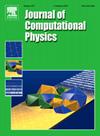孔隙弹性系统智能表征的网络缩放和尺度驱动损失平衡
IF 3.8
2区 物理与天体物理
Q2 COMPUTER SCIENCE, INTERDISCIPLINARY APPLICATIONS
引用次数: 0
摘要
开发了一种深度学习框架,用于从全波形数据中对孔隙弹性介质进行多尺度表征,称为孔隙弹性学。特别注意的是异质环境,其多相性质可能在几个尺度上急剧变化。数据以空间频率描述,采用不同邻域的焦点固体位移和孔隙压力场的形式,根据应用的不同,可以通过远程数据重建或直接测量来提供。目的是同时恢复与Biot方程及其空间分布相关的六种流体力学性质,以鲁棒和有效的方式。两个主要的挑战阻碍了现有最先进的技术为此目的的直接应用:(i)所寻找的属性属于非常不同的和可能不确定的尺度,以及(ii)损失函数是多目标和多尺度的(就其单个组成部分和总损失而言)。为了帮助弥合差距,我们提出了网络缩放的想法,其中神经属性映射由组成缩放层的单位形状函数构造。在该模型中,在训练过程中,未知网络参数(权重和偏差)保持为0(1)。这构成了损失分量及其导数相对于网络参数的显式缩放的基础。因此,我们提出了基于物理的自适应损失平衡的动态缩放方法。首先以多物理场和多尺度PDE系统的一般形式提出了该思想,然后通过一组数值实验将其应用于孔隙弹性学。结果与通过梯度归一化(GradNorm)和Softmax自适应权重(SoftAdapt)进行损失平衡的重建一起呈现。对各种方法进行了对比分析,并给出了相应的结果。本文还对噪声数据的多尺度重构进行了数值研究。本文章由计算机程序翻译,如有差异,请以英文原文为准。
Network scaling and scale-driven loss balancing for intelligent characterization of poroelastic systems
A deep learning framework is developed for multiscale characterization of poroelastic media from full waveform data which is known as poroelastography. Special attention is paid to heterogeneous environments whose multiphase properties may drastically change across several scales. Described in space-frequency, the data takes the form of focal solid displacement and pore pressure fields in various neighborhoods furnished either by reconstruction from remote data or direct measurements depending on the application. The objective is to simultaneously recover the six hydromechanical properties germane to Biot equations and their spatial distribution in a robust and efficient manner. Two major challenges impede direct application of existing state-of-the-art techniques for this purpose: (i) the sought-for properties belong to vastly different and potentially uncertain scales, and (ii) the loss function is multi-objective and multi-scale (both in terms of its individual components and the total loss). To help bridge the gap, we propose the idea of network scaling where the neural property maps are constructed by unit shape functions composed into a scaling layer. In this model, the unknown network parameters (weights and biases) remain of O(1) during training. This forms the basis for explicit scaling of the loss components and their derivatives with respect to the network parameters. Thereby, we propose the physics-based dynamic scaling approach for adaptive loss balancing. The idea is first presented in a generic form for multi-physics and multi-scale PDE systems, and then applied through a set of numerical experiments to poroelastography. The results are presented along with reconstructions by way of gradient normalization (GradNorm) and Softmax adaptive weights (SoftAdapt) for loss balancing. A comparative analysis of the methods and corresponding results is provided. The case of multi-scale reconstructions from noisy data is also numerically investigated.
求助全文
通过发布文献求助,成功后即可免费获取论文全文。
去求助
来源期刊

Journal of Computational Physics
物理-计算机:跨学科应用
CiteScore
7.60
自引率
14.60%
发文量
763
审稿时长
5.8 months
期刊介绍:
Journal of Computational Physics thoroughly treats the computational aspects of physical problems, presenting techniques for the numerical solution of mathematical equations arising in all areas of physics. The journal seeks to emphasize methods that cross disciplinary boundaries.
The Journal of Computational Physics also publishes short notes of 4 pages or less (including figures, tables, and references but excluding title pages). Letters to the Editor commenting on articles already published in this Journal will also be considered. Neither notes nor letters should have an abstract.
 求助内容:
求助内容: 应助结果提醒方式:
应助结果提醒方式:


